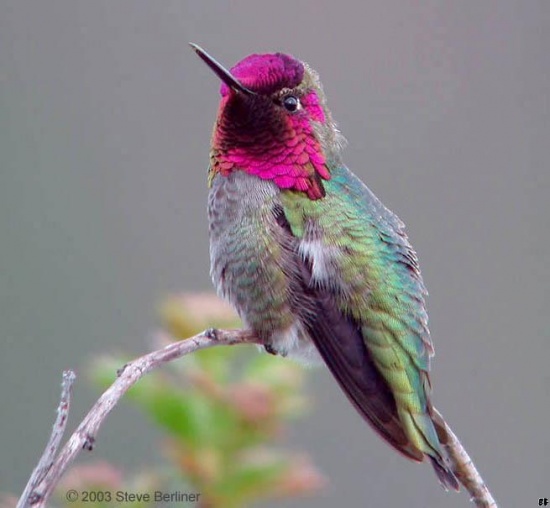(update link) |
(Imp sizes. Some additional info. References updated) |
||
| Line 1: | Line 1: | ||
| − | [[Image:Annas_Hummingbird.jpg|thumb|550px|right|Photo by {{user|Forcreeks|Forcreeks}}]] | + | [[Image:Annas_Hummingbird.jpg|thumb|550px|right|Photo by {{user|Forcreeks|Forcreeks}}<br />Oaks Bottom, Portland, [[Oregon]], March 2003]] |
;[[:Category:Calypte|Calypte]] anna | ;[[:Category:Calypte|Calypte]] anna | ||
==Identification== | ==Identification== | ||
| − | + | 10–11 cm (4-4½ in) | |
| − | *Glossy green back | + | *Short straight black bill |
| + | *Glossy golden-green back | ||
*Grey below | *Grey below | ||
*Green flanks | *Green flanks | ||
| Line 21: | Line 22: | ||
==Habitat== | ==Habitat== | ||
| − | + | Chapparal oak woods, the base of canyons and riparian woodland. | |
==Behaviour== | ==Behaviour== | ||
[[Image:Anna-pena-9-24.jpg|thumb|350px|right|Juvenile<br />Photo by {{user|UncleGus_24|UncleGus_24}}<br />Green Valley, [[Arizona]], September 2010]] | [[Image:Anna-pena-9-24.jpg|thumb|350px|right|Juvenile<br />Photo by {{user|UncleGus_24|UncleGus_24}}<br />Green Valley, [[Arizona]], September 2010]] | ||
====Breeding==== | ====Breeding==== | ||
| − | The female builds a large, round, cup nest in a shrub or tree from very small twigs, lichen and other mosses, and often lined with downy feathers or animal hair. It is bound together with spider silk. | + | The female builds a large, round, cup nest in a shrub or tree from very small twigs, lichen and other mosses, and often lined with downy feathers, soft plant material or animal hair. It is bound together with spider silk. The eggs are generally laid between November - May. |
====Diet==== | ====Diet==== | ||
| − | The diet includes nectar and insects. | + | The diet includes nectar of native and introduced flowers, shrubs and trees and also insects. |
==References== | ==References== | ||
| − | #{{Ref- | + | #{{Ref-Clements6thAug15}}#Avibase |
| + | #Handbook of the Birds of the World Alive (retrieved January 2016) | ||
#Wikipedia | #Wikipedia | ||
| + | {{ref}} | ||
==External Links== | ==External Links== | ||
{{GSearch|Calypte+anna}} | {{GSearch|Calypte+anna}} | ||
Revision as of 20:18, 14 January 2016
- Calypte anna
Identification
10–11 cm (4-4½ in)
- Short straight black bill
- Glossy golden-green back
- Grey below
- Green flanks
- Long, straight and slender bill
Male:
- Glossy red crown and throat
- Dark tail
Female and juvenile:
- Green crown
- Grey throat with some red marking
- Dark tail with white tips.
Distribution
North, South and Central America: found in the arid south-west of British Columbia to north-western Baja; winters to northern Mexico
Taxonomy
This is a monotypic species[1].
Habitat
Chapparal oak woods, the base of canyons and riparian woodland.
Behaviour
Breeding
The female builds a large, round, cup nest in a shrub or tree from very small twigs, lichen and other mosses, and often lined with downy feathers, soft plant material or animal hair. It is bound together with spider silk. The eggs are generally laid between November - May.
Diet
The diet includes nectar of native and introduced flowers, shrubs and trees and also insects.
References
- Clements, J. F., T. S. Schulenberg, M. J. Iliff, D. Roberson, T. A. Fredericks, B. L. Sullivan, and C. L. Wood. 2015. The eBird/Clements checklist of birds of the world: v2015, with updates to August 2015. Downloaded from http://www.birds.cornell.edu/clementschecklist/download/
- Avibase
- Handbook of the Birds of the World Alive (retrieved January 2016)
- Wikipedia
Recommended Citation
- BirdForum Opus contributors. (2024) Anna's Hummingbird. In: BirdForum, the forum for wild birds and birding. Retrieved 8 May 2024 from https://www.birdforum.net/opus/Anna%27s_Hummingbird
External Links






